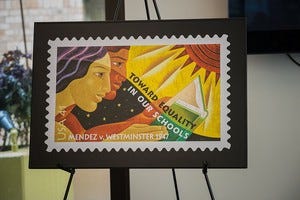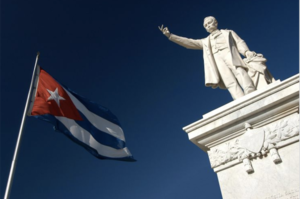Pieces written by and about various US Latinos and Latin Americans
To help pay tribute to amazing Hispanic authors, poets, and social activists, we put together a collection of 9 texts for you to use to celebrate National Hispanic Heritage Month with your students:
3rd-4th Grade:
“The Child” by J. Patrick Lewis
In this poem, American poet and prose writer J. Patrick Lewis writes about the life of Sylvia Mendez, an important Civil Rights activist of Mexican–Puerto Rican heritage. Mendez is known for her efforts in the desegregation of schools in California.
Use this assignment as an opportunity to ask your class how they think students were affected by being placed in separate schools because of their ethnicity. You can also urge them to think about what lessons they learned from the poem to help fight and overcome discrimination today.

5th-6th Grade:
“Names/Nombres” by Julia Alvarez
Born in New York, Julia Alvarez is a Dominican American poet, novelist, and essayist. Much of her work focuses on her experiences as a Dominican in the United States.
This short memoir discusses the multiple names she has been given over the years by those who could not pronounce her name in Spanish. When teaching this text, you can facilitate a text-based discussion about the connection between our names and identities, and enrich the lesson by showing the related media video of Alvarez discussing her experiences writing in English.
“I Am Offering This Poem” by Jimmy Santiago Baca
Jimmy Santiago Baca is an award-winning American poet and writer, of Apache and Chicano descent. While serving time in prison as a young man, Baca taught himself how to read, write, and create poetry.
In this poem, Baca describes the power of love, especially in the face of hardships. Engage your students with this lesson by discussing the meaning behind Baca’s compelling figurative language and the universal theme conveyed by his poem.
7th-8th Grade:
“Amigo Brothers” by Piri Thomas
A writer and poet, Piri Thomas was born to a Puerto Rican mother and Cuban father. During his childhood, Thomas lived in East Harlem, which became known as “Spanish Harlem.”
In this short story, two best friends become competitors when they must fight each other in a boxing match. Pair this text with “At The Head of Her Class, And Homeless,” and discuss with your students how the two texts explore what it takes to be successful.

“Abuelito Who” by Sandra Cisneros
If you are looking for a lesson in Spanish, check out “Mi Nombre” by Cisneros.
Sandra Cisneros is an American writer and key figure in Chicana literature. Her writing frequently draws on her experiences as the only daughter in a family of six brothers, and her family’s constant migration between Mexico and the United States.
The speaker in this poem describes their aging “abuelito” (grandfather).Bring your students closer to the text by asking them to discuss how age has affected someone close to them and how this process changed their relationship with the person.
9th-10th Grade:
“Sonnet XVII” by Pablo Neruda
Pablo Neruda was the pen name and, later, legal name of the Chilean poet-diplomat and politician Ricardo Eliécer Neftalí Reyes Basoalto. Neruda became famous worldwide for his intense and original poetry, especially his poems about love.
Neruda’s poem “Sonnet XVII” is one such piece about an intense, “secret” love. Have your students compare Neruda’s poem to Yrsa Daley-Ward’s poem “What Love Isn’t,” and ask students to consider how experiences of love are similar or different across cultures.
“Address to the Commonwealth Club of California” by Cesar Chavez
Cesar Chavez (1927–1993) was a Latin American civil rights activist who strongly advocated nonviolent tactics and unionism in order to make the struggles of Mexican American farmworkers a nationwide cause. Chavez, the President of United Farm Workers of America, gave this address to the non-profit, non-partisan educational organization, the Commonwealth Club of California, on November 9, 1984 in San Francisco.
Use this piece to start a conversation in your classroom about Chavez’s thoughts on social change. Ask your students what inspired Chavez to lead a social movement to fight for farmworkers’ rights and what broad effects this movement had in our society. Encourage your class to talk about impactful social movements happening today.

11th-12th Grade:
Excerpt from “Our America” by José Martí
We also offer Spanish texts by Martí for lower grade levels, such as “Dos Patrias” and “Mi Caballero.”
José Martí (1853–1895) was a Cuban poet, essayist, journalist, and political theorist who wrote about the newly independent nations that arose as a result of the Latin American Wars of Independence in the late 18th and early 19th centuries.
In this excerpt from the essay “Our America,” Martí discusses the evolution of leadership in Latin America and his hopes for the future. To provide your students with more context, have them watch “Latin American Revolutions: Crash Course World History #31” and discuss the ways in which Latin American societies changed and stayed the same after their independence. In this context, have your students consider Martí’s ideas about leadership and the role of education in the process of nation building.

“A Very Old Man With Enormous Wings” by Gabriel García Márquez
Gabriel García Márquez (1927–2014) was a Colombian novelist, short-story writer, screenwriter, and journalist. He is considered one of the most influential writers of the 20th century and received the 1982 Nobel Prize in Literature.
The short story above tells the tale of an old man with wings who disturbs a quiet town after crashing into a family’s yard. After analyzing the magical realism and the characterization in the story, show the video “Understanding ‘A Very Old Man with Enormous Wings,’” which proposes different interpretations of the story. Have students discuss which interpretation they believe is the “best” or “right” interpretation, backing up their thinking with textual evidence.
Next Steps
Take a look at our entire library for more reading passages celebrating Latino experiences and contributions. We are always adding to our library, so keep checking back for more updates!
If you’re interested in learning all about CommonLit’s free digital literacy program, join one of our upcoming webinars!


